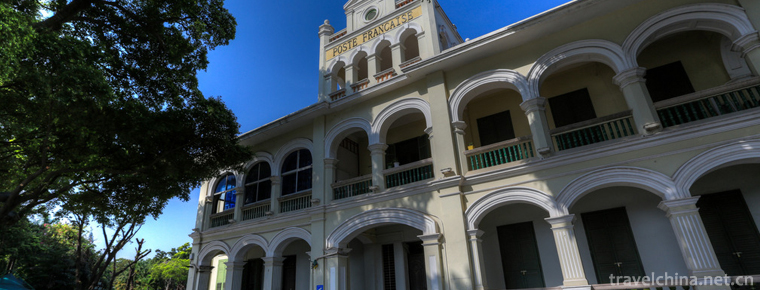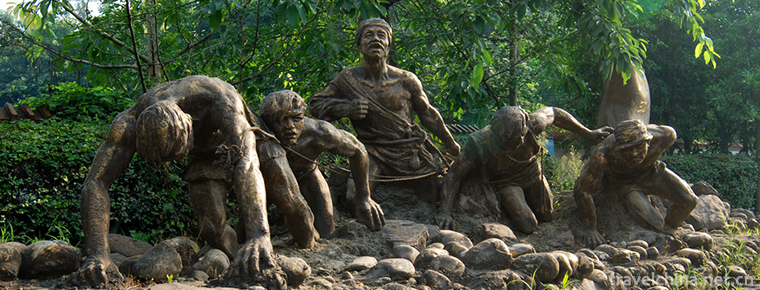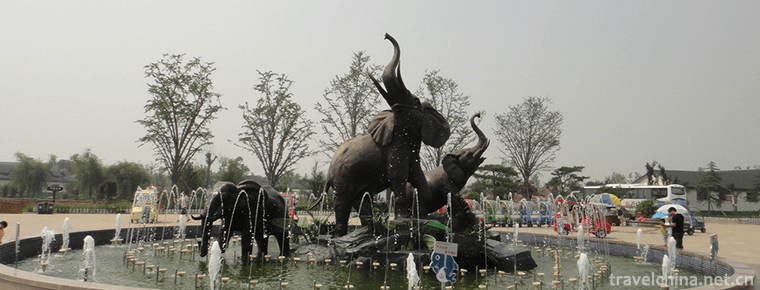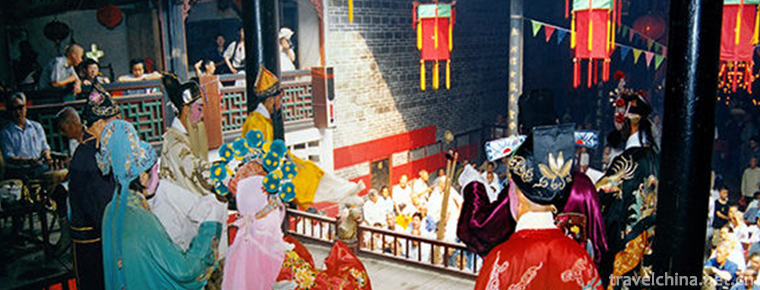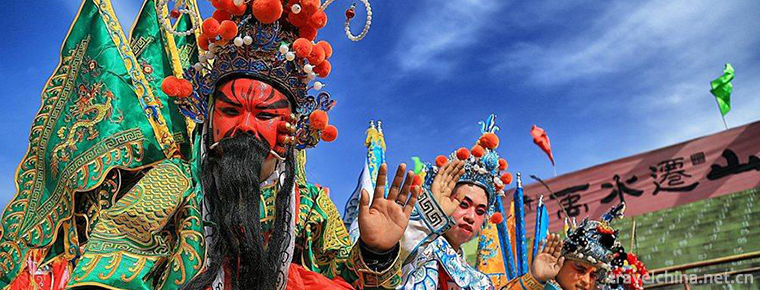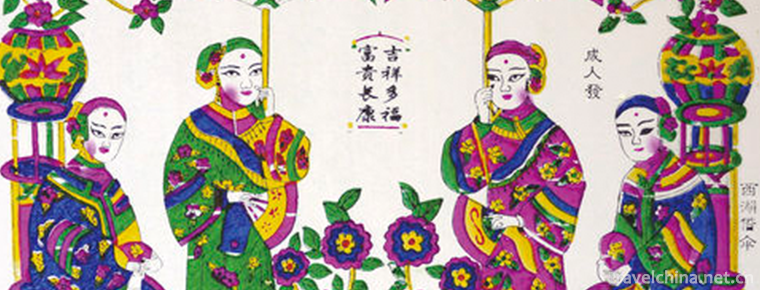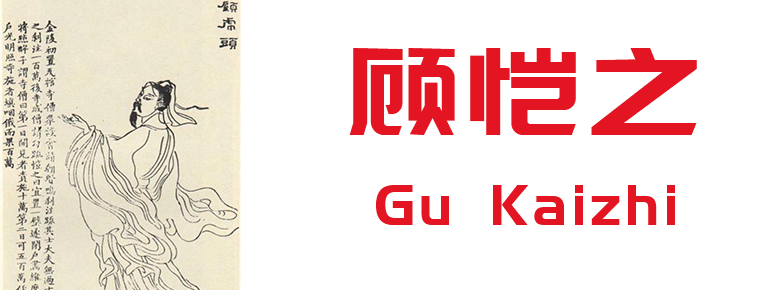Traditional Toys Tancheng Wooden Rotary Toys
Traditional Toys Tancheng Wooden Rotary Toys
Tancheng Wooden Rotary Toy is an ancient traditional handicraft. Originated in Fanyuan Village, north of Gangshang Town, Tancheng County, Linyi City, Shandong Province, it is commonly known as "playing goods", which originated in the late Yuan and early Ming Dynasty and has a history of more than 600 years.
It has a strong local flavor. Its subject matter, content and art form are all produced to adapt to the characteristics of rural areas, with strong local characteristics. In the pattern design, it is mostly based on folk myths, folk stories, historical stories and so on. It has the characteristics of exquisite shape, vivid image, brilliant color, exaggeration and vividness.
On November 11, 2014, Tancheng Wooden Rotary Toys were approved by the State Council and listed in the fourth batch of national intangible cultural heritage list.
Essential information
Cultural Heritage Name: Tancheng Wooden Rotary Toys
Date of declaration: 2006
Declarer/Declarator: Linyi City, Shandong Province
Heritage Level: National Level
Process Overview
Since its founding, Tancheng Wood Rotary Products have been centered on Fanyuan Village, handed down from generation to generation, and passed down to the 19th Dynasty, and there have been more typical inheritance figures in successive dynasties, constantly innovating Wood Rotary Products. Since the 1970s and 1980s, Tancheng Muxuan toys, represented by Fan Jimei, a villager, have produced Peking Opera masks and puppets. The production of Fanyuan Muxuan toys has completed the transformation from manual to machine production. According to data, they have produced more than 600 kinds of wooden rotary toys in 10 categories. Traditional works include ancient characters, tiger head sticks, high and low stick stickers, swallow carts, birdcarts, eight immortals flower trays, monks knocking wooden fish, tumblers, Peking Opera Facebook, flower baskets, groceries, wooden bowls, pullers, turnout drills and so on. Innovative varieties include walnut people, small trains, rockets, aircraft, artillery, intelligence platter, etc. The products not only won prizes in national folk arts and crafts competitions or exhibitions, but also were collected by China Art Museum and Song Qingling Foundation. They were exported to more than 30 countries and regions, such as Japan, the United States, South Korea and Singapore, and earned more than US$1 million annually. Fanwei Village has become a well-known "town of wooden mooring toys".
Folklore
As for the origin of Fanwei Village, the hometown of Mofu toys, an ancient folklore is widely spread among the local people. Legend has it that during the Chenghua period of the Ming Dynasty, Fan Mu, the ancestor of Fan family, fled from Ganyu in Jiangsu Province to Yishui River and settled on the East Bank of Yihe River, 30 miles west of the city. Being forced to earn a living, Xu Mou, a carpenter from a nearby village, was invited to study art as a teacher. He soon mastered all kinds of skills and became an excellent carpenter. Fanmu is skillful and skillful. According to the principle of turning the drill bit by pulling the belt by hand, he made a simple rotary car. Start making simple toys like knife holders and flower-stick hammers. Later, Fanmu gradually explored a set of techniques for making wooden mooring toys. In his later years, he passed on his craft to his children and grandchildren. Later, almost every household, men, women and children began to make wooden revolving toys. This craft has been handed down from generation to generation. The place where Fanmu settled in that year gradually developed into the present "Fanyuan Village".
Process characteristics
Tancheng wooden rotary toys are rich in local flavor. Its subject matter, content and art form are all produced to adapt to the characteristics of rural areas, with strong local characteristics. In the pattern design, it is mostly based on myths, folk stories, historical stories, etc. It has the characteristics of exquisite shape, vivid image, brilliant color, exaggeration and vividness. Some wooden rotary toys use mechanical principles, toys can move, and sound accompanied, very interesting, loved by the masses. These seemingly ordinary wooden revolving toys, however, contain ancient cultural connotations, and imply the role of protecting students and eliminating evil spirits in the game. Wooden rotary toys are made of wood of different lengths and thicknesses. The process of making wooden rotary toys begins with scraping bark. To scrape the bark of a tree is to scrape the bark of a willow tree with a sickle. After the bark is scraped, the wood is cut into sections, and then the wood can be used. The wood used for making wooden toys is usually thicker branches. The main cadres of trees can be used to make furniture. Branches of twigs can not be left to make things. It is a pity that they are thrown away and used to make wooden revolving toys. Then start to make blanks, that is, in the spinning machine, first turn the wood into various blanks, make different wooden rotary toys have different blanks. If you are a stick man, you will have two parts: body and head, more swallow parts, handlebars, wheels and boards. When the blank is ready, the colour is applied. First of all, it is "powder", that is, to coat the wood surface with a layer of powder, which is a mixture of talc powder and water gel. The purpose of this is to make the color uniform. After the foundation is dried, the color on the top can be restored only after the foundation is dried. The common colors of traditional wooden rotary toys are peach red, grass green, brilliant yellow and other gorgeous colors. The patterns used in color painting are generally handed down from generation to generation by older artists. According to different types of toys, various flowers, animals and other suitable patterns are painted. The colours and patterns are very local and local. After the color is added, it is put in the sun to dry, and the whole production process is completed.
Inheritance significance
In the words and deeds of their predecessors, their descendants made various daily necessities such as knives and handles, and toys such as flower baskets, flower drums, fireworks, high and low baseball players, which were sold in busy markets, temple fairs and other places to subsidize household use. These simple wooden revolving toys were still the envy of children a few years ago. They were sold at various temple fairs and mountain fairs. In the days without video games, televisions and various plastic electric toys, these wooden toys originated from the folk with local flavor constitute the happiest childhood life of children, which indicates the warmest childhood memories. The children born in Fanyuan Village have been learning this craft with their parents since childhood. Because there are many people and few land in Fanyuan village, it is difficult to maintain a family's life by planting land alone. Therefore, the craft of making wooden rotary toys is regarded as a farm work by Fanyuan villagers. Almost every family in the village has a "revolving car". Villagers usually work in agriculture, and they begin to be busy after winter. "Fanjiayan is close to the Dayi River, and the whole family plays cards. It's no use juggling, but the doll is laughing. It is not difficult for the doll to defeat the aggressor by playing tricks instead of carrying on by her mother, so that she can spare her mother a lot of work and produce more. This song was compiled in the 1950s, from which we can see the production of wooden spinning toys.
Inheriting characters
Fan Jimei, the heir of Tancheng Wooden Rotary Toys, grew up in such an environment. He helped adults learn to color and glue wooden Rotary Toys like planting wheat and peanuts when he was six or seven years old. He picked up a brush to help draw some simple patterns after school, and naturally learned to make wooden Rotary Toys. In many years of production, Fan Jimei gradually mastered the production process of wooden rotary toys. Fan Jimei joined the army in 1970 and spent seven years in the melting pot of the army. Although Fan Jimei did not have access to wooden rotary toys in the army, he grew more talents in these seven years. At that time, he was a clerk in the army, known as the "Xiaoxiu talent" in the army, and published articles in newspapers. It was also because of seven years'training in the army that he laid the foundation for later returning home to work as a factory director for the welfare of the villagers. Fan Jimei retired from the army in 1977. After returning to the village, he returned to the old toy industry and produced wooden toys in his own home, such as tiger head hammer, swallow cart, high and low stick stick man and so on. However, at that time, all the wooden revolving toys made in Fanwei Village were family-style handicraft workshops, making small noises and producing small quantities. From then on, Fan Jimei picked up the craft that she grew up with when she was a child, and continued the craft work that she had to engage in all her life.
Process development
With the social attention to Tancheng Mufu toys as a folk cultural heritage, in 1985, Fanwei Village established the "Wood Rotary Products Research and Development Center" specializing in the research and development of wood Rotary Products. As a principal person in charge, Fan Jimei's research and development of wooden spinning toys has made great contributions to the inheritance and protection of Tancheng traditional wooden spinning technology. As soon as the "Wood Rotary Products Research and Development Center" was established, Wang Zhanlun, a well-known craftsman and artist in the city's Foreign Trade Bureau in his 70s, gave art guidance and trained a lot of painting talents, all of which laid a good foundation for the development of Fanyuan Village into a well-known toy village. Fan Jimei, who knows the technology and has done some paperwork in the army, was recommended as the first factory director. Fan Jimei's research and exploration of toys came along with it. At that time, the village mainly produced high and low stickers. This kind of toy was relatively rough. Because of the different dyes used, the toys always looked rustic, and the color faded over time, but also sticky. Fan Jimei was thinking about how to make toys look both simple and exquisite in the simplicity of folk tradition. He began to do some research experiments on dyes and changed traditional dyes into paints, which not only looked exquisite but also bright. Fanyuan Village is more famous for its wooden spins.
At that time, making wooden rotary toys mainly relied on the "rotary car", while the village used to make wooden rotary products "rotary car" has been using the ancient manual style, time-consuming and laborious. At the end of 1980s and the beginning of 1990s, under the leadership of Fan Jimei, the Craft Gift Factory carried out a transformation of production tools, mainly introducing new technologies. It developed an automatic "revolving car" machine, which changed the direction of wooden revolving toys from manual production to machine production, and greatly improved the production efficiency. At the same time, Fan Jimei found that the quality of the pigments used in the past was too poor, and when she played with them, the color would stick to her hands. After experimentation, Fan Jimei chose to use paint to color, so that the color was bright and would not fade, and the preservation time was long, which made the wooden rotary toys popular with more people. Fan Jimei is a conscientious person. When he sees some woodworking products outside, he always brings them back to ponder. If he adds or subtracts a little, he makes something new in his mind. He not only inherited the wooden spinning handicraft handed down by his ancestors, but also made innovations from time to time. On one occasion, when he left Jinan, he saw that the toothpick box was pillar-shaped, so he brought it back to study. He thought that if he changed the round hat, it would look better, and he initially planned to carve some patterns on the outer shell, which would certainly look better than the original one. Say dry, an oval wooden toothpick box was developed by Fan Jimei.
"Every family is busy with paintings when the revolving car rings." With the improvement of production tools, Fanwei Village's wooden rotary toys have entered the peak period of production. The more famous Tancheng wooden rotary toys are, the more far away they are. Often, customers at home and abroad take samples to the factory to process them. According to the samples of some products on the foreign market, and according to the needs of the domestic market, they began to ponder and design wooden revolving toys, such as "Japanese dolls" in kimonos, Santa Claus, walnuts and so on, which meet the preferences of people in different countries and places. The earliest foreign trade product is Yimei crafts company in the United States. They took the wooden "walnut man" sample. It is said that it is very popular abroad and can avoid evil. Fan Jimei made the first "walnut man" with the combination of Chinese and Western. The American customers are very satisfied, and a large number of orders follow. From 1985 to 1989, a number of American companies came in succession. At a Canton Fair in 1989, their toys attracted a large number of customers'interest, including an American businessman who took a fancy to their toys, and in that case the factory successfully received an order of 3 million yuan. However, due to the transition from planned economy to market economy at that time, craft and gift factories gradually entered a difficult position. In 1991, Fan Jimei left the factory reluctantly. After returning home, Fan Jimei, who was unwilling to give up, began to prepare and produce wooden revolving toys at home, and designed some modern wooden revolving toys, such as Peking Opera Facebook, Puppet Man and Travel to the West. In 2003, Fan Jimei took his wooden mobiles to the Tsingtao Beer Festival. At this beer festival, his toys were snapped up and sold very well. On the basis of excavating and protecting the old products, Fan Jimei keeps innovating, so that the wood spinning products are sold to more than 30 countries and regions such as Japan and Korea.


-
Taimu Mountains
Taimu Mountain is located in the northeast of Fujian Province. It is 45 kilometers south of Fuding City from the urban area..
Views: 191 Time 2018-12-08 -
Shennong Creek Scenic Area
Shennongxi, originating from the main peak of Shennongjia, flows through Badong County, Hubei Province. It travels from north to south through deep mountain canyons, and converges into the Yangtze Riv.
Views: 147 Time 2018-12-12 -
Linyi Animal and Botanical Garden
Linyi Animal and Botanical Garden is a national AAAA-level tourist attraction , located at the core of Linyi Economic and Technological Development Zone, Shandong Province.
Views: 223 Time 2018-12-22 -
nanling national forest park
Nanling National Forest Park is the largest nature reserve in Guangdong Province and a treasure house of rare animals and plants. The park is located in the core of Nanling Mountains.
Views: 138 Time 2018-12-31 -
Donghe Opera
Donghe Opera, one of the national intangible cultural heritage, is a traditional drama in Donghe area of Ganzhou City, Jiangxi Province..
Views: 176 Time 2019-04-27 -
Folk fire Min Jian She Huo
Folk society fire is a kind of folk entertainment popular in China during the Spring Festival. It is widely spread in Shaanxi, Shanxi, Hebei, Henan, Liaoning and other provinces. On May 20, 2006, Folk.
Views: 155 Time 2019-06-05 -
Beach Head Wood Engraving New Year Pictures
Tantou woodcut New Year's picture is the only handmade woodcut watermarking New Year's picture in Hunan Province. It has its own style with strong local characteristics in southern Chu. Tantou Town is.
Views: 296 Time 2019-06-18 -
Zhou Cuns Baking Cake Making Skills
Zhou Cun's baking technology has a history of more than 1,800 years. According to Zizhi Tongjian, in the three years since Emperor Heng of Han Dynasty Yanxi, Hucai vendors have been exiled in Shandong.
Views: 290 Time 2019-08-10 -
Gu Kaizhi
Gu Kai Zhi (348 to 409 years), the word is long, the small character tiger. Han nationality , Jin Ling Wuxi people (now Wuxi, Jiangsu province). Outstanding painter, painting theorist and poet. Becaus.
Views: 171 Time 2019-09-07 -
Zhenwu mountain ancient Temple Group
Zhenwu mountain ancient Temple group is located in the urban area of Yibin City, adjacent to Cuiping mountain, with an altitude of 396 meters. It is named for Zhenwu temple on the mountain, covering an area of more than 50 mu..
Views: 226 Time 2020-10-16 -
Shixiang Lake
Shixiang lake is named after Shixiang temple, an ancient temple in the lake area. It is said that it was the place where Yan Yan, a general of the Three Kingdoms, rode an elephant to heaven. .
Views: 199 Time 2020-10-16
